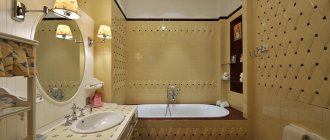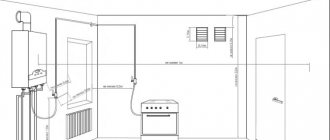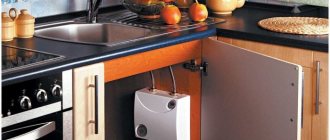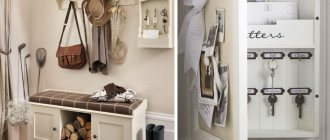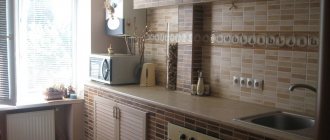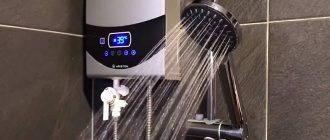When searching for the optimal water heater, it is worth considering that instantaneous variations are more compact, while tanks of storage models have significant dimensions . Before purchasing equipment, experts recommend deciding where it will be installed so that it is more convenient to use, and the appearance of the structure is in harmony with the style and decoration of the bathroom.
Requirements for the room and installation location of the geyser
The installation location of the gas heater and water heater is regulated by certain standards that must be adhered to when performing any work.
Basic standards:
- The dimensions of the water heater should not be less than seven cubic meters.
- The height of such an installation should be more than two meters. In accordance with standard standards, this height is quite sufficient.
- In the room where the column is located, glazing is mandatory.
If you plan to install a gas heater in an apartment for the first time, you cannot do without obtaining the appropriate permits from gas services.
Window openings should be large and allow opening at any time. Air stagnation is not allowed where the geyser is installed. Stagnant air currents will pass through the window. It should also be taken into account that a door is usually installed in the kitchen to ventilate and create optimal conditions. If it is not there, then it is necessary to provide for installation work in the design documentation.
A transfer project is drawn up if the device is moved more than 1.5 meters from the previous installation area.
Many people wonder whether it is possible to put the geyser in the closet. This can be done, but many nuances need to be taken into account. A gas testing device must be installed in the room. It will help you identify a leak in time to take appropriate action.
Note! The location of all equipment should be determined in advance. It is better to draw up a floor plan that will be easier to navigate.
The transfer of equipment is allowed by one and a half meters. This is quite enough to completely change the layout of the room. If a larger transfer distance is planned, this will be a complete replacement of the system. You will have to reconnect all the equipment to the main line, which will cause some difficulties. Other documents will also be required to approve the redevelopment, and the time frame for completing repair work will increase.
Work order
The general algorithm for masking plumbing communications is as follows:
- Inspection of the premises, making a decision on how to close the opening.
- Drawing up a sketch and diagram, carrying out calculations of building materials, checking tools.
- Preparing the box for fastening the cladding and fasteners.
- Manufacturing of the basic structure.
- Finishing of the building.
Upon completion of installation, the performance of the screen is checked and minor deficiencies are eliminated.
Basic installation safety rules
It is required to follow many rules and features when installing a gas water heater and water heater. Otherwise, owners may be fined large sums.
It is important to equip the chimney and ventilation system. The efficiency of moving air flows, as well as the timely removal of smoke from the room, depends on this.
It is strictly forbidden to install the unit above a sink, refrigerator, or gas stove.
The ventilation hole must be of such a size that air can easily pass in the required quantities without clogging the main components of the system. If you forget about this requirement, then over time a large amount of toxic substances can lead to emergency situations, as well as poisoning of all residents in the house. The risk of gaseous waste explosion increases. This is especially true at night, when people are physically unable to detect a gas leak in the house.
Access to the gas water heater should be as free as possible. This will ensure quality service and the ability to inspect the device if necessary.
In order for the gas water heater to function normally, it is necessary to arrange a passage to the chimney. It can be connected to a common main line or mounted independently. During installation, it should be taken into account that the number of bends for normal air flow should not exceed the established norm. Otherwise, difficulties arise with transporting air flows to the outlet. The length of the chimney is established by law. Otherwise, a chimney pipe will be required to ensure normal levels of air circulation.
Do not mount the device too low or high.
The installation location of the gas outlet pipe is located in such a way as to provide optimal outlet for the column. For installation, you should use pipes that are made of substances that are resistant to combustion processes. Increased risk of fire. The best option would be pipes that have a low degree of thermal conductivity.
The pipe is usually connected in a vertical position. The length of this section is at least fifty centimeters for normal operation of the installation. In some cases, it is permitted to use corrugated pipelines. There should not be any sagging or unevenness.
It is advisable that the boiler be at eye level or at least within sight.
If it is not possible to install a chimney, you need to take care of another method of removing gases. For example, you can install a powerful hood that has sufficient draft to remove gas outside. It is necessary to arrange the system in accordance with the design documentation.
Many owners of houses and apartments have a natural question whether it is possible to cover the gas water heater with a cabinet. It can be done. At the same time, it is important to follow certain rules for placing the dispenser so that there are no problems with the gas service.
It is better not to decorate the walls near the speaker with wallpaper and plastic panels. The surface on which installation is to be carried out must be covered with non-flammable materials.
The water heater must not be connected to a load-bearing wall. You also cannot install the column using this method. This can be explained by the fact that in the event of an explosion the entire house could collapse. To clarify this issue, you should contact specialists. They will conduct research of the area, which will help determine the method and location of installation of the structure.
It is also necessary to follow certain rules for placing the system. Treatment of the area in the stopping area must be made from materials that are resistant to combustion. This will help prevent the possibility of a fire. The structure cannot be installed on wooden surfaces. This will require pre-processing.
In the room where the heater operates, you should not overdo it with waterproofing and insulation of windows.
To achieve high safety of the geyser, you should not install it above other gas appliances. It is recommended to keep your distance. It is necessary to carefully check the sealing of each channel and install the pipes in accordance with legal regulations.
The easiest way out of roller shutters
The fastest way to solve the problem of hiding the sewerage is with the help of roller shutters. This design maximizes access to the pipes, while there are no doors cluttering the space. Hanging blinds requires no experience, and beautiful curtains do not require any additional finishing.
Plumbing roller shutters are not only beautiful, but also practical
In response to the increased demand, manufacturers produce special sanitary roller shutters, endowing them with noise-insulating and heat-saving properties. If desired, it is easy to choose a color that harmonizes with the decoration of the entire room.
What to do is strictly prohibited
In accordance with current legislation, it is prohibited to independently install gas appliances without prior approval of the relevant project and work. Otherwise, the person will bear criminal liability.
For residents of small apartments, where the kitchen area does not exceed 6 m², an exception is provided: they can hang the column above the sink.
It is not allowed to install such devices in conditions of high humidity. Also, you should not equip it with plastic and synthetic products nearby.
You cannot do forced traction. The law prohibits the installation of gas connection installations on supporting structures. Water hoses must not be used for connection. There are other types of installations for this purpose.
It is imperative to have a high-quality, unclogged ventilation system with natural air flow.
Cheap DIY toilet finishing with broken tiles
Craftsmen are reluctant to take on small-scale repairs – in particular, this applies to toilets. This bathroom was not only renovated with your own hands, but also in an unusual way: there were broken tiles on the walls.
I plan to hang the 80 liter flat water heater in the corner of the bathroom, not in a niche. Please advise how to close a huge water heater at eye level
Galina
- Like | 5
- Save
Galina
- Like
- Save
How to hide a gas water heater in the kitchen
There are several different ways to disguise a structure in the kitchen. Certain requirements must be followed and safe materials must be used to complete the task.
Is it possible to cover a gas water heater with a cabinet?
It can be done. At the same time, you need to comply with certain requirements in order to protect yourself and your loved ones. The cabinet must be made of materials that are resistant to combustion. It is also important to maintain the distance between the walls of all devices. A solid cabinet can be used when the water heater has its own combustion chamber.
When looking for solutions on how to effectively disguise a geyser, you need to adapt to the restrictions and requirements specified above.
Painting the walls and kitchen units in color
One of the simplest and most accessible methods. It is enough to choose furniture to match, purchase suitable paint and complete all the work. It doesn't take much time, and the result will please you. To paint the product, you must purchase a special paint that is resistant to external factors.
Inexpensive to implement, stylish and the easiest way to integrate a speaker into the interior is to choose a suitable model or paint an existing unit to match the tone of the walls, furniture, and individual interior elements.
Installing a speaker between cabinets
One of the effective ways. Quite easy to implement. Suitable when it is not possible to integrate the equipment into a furniture set. An open or closed design option is allowed. Additionally, holes can be made to provide better ventilation.
You need to try not to overuse too bright colors, take into account the theme and overall color scheme of the kitchen.
Moving the column to the corridor
If the kitchen is small, you can think about installing it in the hallway. In this case, a number of requirements must be observed. The room must correspond to the established dimensions. You also need to contact the gas service to coordinate the procedure. Sometimes you can move the water heater into the bathroom. In this case, you also need to obtain the appropriate permission.
Moving the speaker to the corridor is the optimal solution for owners of Khrushchev-era apartments and modest-sized premises.
Decorating the unit
One of the simplest and least expensive ways. With the help of various decorative elements you can easily transform the appearance of the water heater and column. You can use stickers, photos, paintings, paintings, and various ornaments as decoration. You can also immediately purchase a decorated model so as not to waste extra time on decorating yourself.
The procedure will not require permission from regulatory authorities and will not be difficult to implement for creative people.
Designs for masking the boiler
At the initial stage, it should be taken into account that manufacturers of water heaters provide at least an average level of decorative value for the body of the water heater, meaning its installation on walls or on the floor without additional camouflage.
Thus, choosing a ready-made cabinet for a bath, hallway, kitchen or corridor, inside which a water heater will ideally fit, without gaps and dismantling some shelves, is a very difficult task. Since the owner does not yet have either a cabinet or a boiler, he runs around the shops and compares their mutual dimensions until they are completely compatible.
The exception is “under the sink”, “under the sink” boilers installed in floor cabinets. However, they are all low-power, since it is physically impossible to stuff large-volume tanks into small-sized furniture.
Therefore, structures inside which a storage water heater can be hidden are usually built by a home craftsman himself.
Box
A box is a structure that protrudes outward relative to the plane of the wall. Roughly speaking, this is a cabinet made of gypsum plasterboard sheets screwed onto a frame made of galvanized profile. Unlike a cabinet, the structure is stationary and non-removable. Instead of a door for access to the interior, an inspection hatch is used - hinged, sliding, push-button, removable.
The box manufacturing technology is as follows:
- fastening, piping the water heater (this will be problematic to do later);
- fixing the guide profile;
Attaching the starting profile. - installation of a rack profile;
- frame assembly;
Frame installation - installation of an inspection hatch;
- covering the frame with plasterboard;
Fastening gypsum board sheets. - finishing of external surfaces with tiles.
The box can be vertical from the ceiling to the floor or half the length of the wall, horizontal, stepped, of a complex configuration, depending on where the water supply and boiler are located.
Niche behind the toilet
Unlike the previous option, the niche is sewn up with one panel; there are no sides.
Material consumption is reduced and the labor intensity of the process is reduced.
A popular way to disguise engineering systems and water heaters in the niche behind the toilet are blinds, as in the bottom photo.
Pipes may interfere with fixing the electrical appliance to the wall using standard fasteners. In this case, brackets or special fastening systems are used.
Adjustable fastening system made of profile perforated pipe with brackets.
In this case, a stepped box is used, the wall is built up only above the toilet.
Niche under the kitchen window
Step-by-step instructions for hidden installation of a storage water heater in a niche under a kitchen window are as follows:
- dismantling standard doors, shelves lining internal surfaces;
- sewerage, electrical, water supply installations;
- finishing niche surfaces;
- installation of a water heater, installation of engineering systems;
- installation of inspection hatch, sliding and swing doors, blinds.
Access to the water heater body is necessary in order to clean the tank from scale and change the anodic protection electrodes.
Mezzanine
In the standard version, the mezzanine shelf is used to store household items. In this case, the purpose of this architectural structure changes. The shelf is equipped with blinds or doors, and a storage boiler is installed on it. The sequence of operations for manufacturing a mezzanine for a water heater is as follows:
- horizontal mark on opposite walls of the corridor;
- fastening bars or profiles to walls;
- laying the shelf on profiles/bars; Installation of the mezzanine step by step.
- installation of doors or blinds;
- installation of a water heater, connection to the electrical network, water supply, sewerage.
Installation of the boiler on the mezzanine.
Attention: Only horizontal models of water heaters must be installed on the mezzanine. It is not allowed to lay vertical boilers on their sides.
Wall cabinet
The option of installing a single-circuit electric boiler in an industrially manufactured wall cabinet is the least labor-intensive, but the most costly in terms of finances. The main installation nuances are:
- the standard cabinet fasteners will not support the weight of a storage heater with a full tank of water;
- the boiler is attached directly to the wall, either through the back wall of the furniture, or after its dismantling;
- to connect to sewerage, cold water, and hot water circuits, it is best to install water sockets inside the cabinet on the wall of the room;
- To connect to a 220 V network, an electrical outlet with grounding is inserted into the cabinet in the same way.
Plastic and composite pipes are always cheaper than long flexible metal hoses and last several times longer.
Closet
The interior solution “boiler inside a wardrobe” is optimal for a corridor or hallway. It is in these rooms that such furniture is used most often, and they are located in close proximity to the bathroom and kitchen. You can connect to the sewer/water supply through the wall. To do this, the back or side wall of the wardrobe must be the enclosing structure of a bath, toilet or kitchen.
The design of the built-in wardrobe is extremely simple - the doors move from ceiling to floor on rollers along guides, there are no side or rear walls. The upper part of one furniture compartment is allocated for the boiler; standard shelves for storing things are installed in the remaining space.
Floor stand
Due to the small size of bathroom cabinets and floor cabinets for kitchen sinks, it is impossible to fit a large-volume storage single-circuit electric boiler inside this furniture. Single-door cabinets accommodate a device with a maximum 30 liter tank, double-door cabinets - with a 80 liter tank.
Water heaters are installed on a cabinet shelf or attached to the wall of the room, and may have legs.
Design options for rooms with a gas water heater
You can decorate a room with a geyser in different styles:
- Loft style. You can easily disguise the device as modern technology from futuristic films.
- Country style. The best solution would be a speaker made in pastel colors. In the Provence style, floral arrangements are welcome.
A geyser can fit perfectly into other types of premises. It is enough to use thematic decorative elements, as well as show a little imagination.
How to hide a water heater in the bathroom?
Modern water heaters are attractive in appearance, unlike old boilers. There is no need to hide them specifically, only if there is such an opportunity. A small boiler (up to 30 l) will fit under the sink (washstand). Storage water heaters are hidden in niches, wall cabinets, behind blinds, inside plasterboard boxes.
Complete turnkey apartment renovation
- Everything is included The cost of repairs includes everything: work, materials, documents.
- Without your participation After agreeing on the project, we only bother the owners when the repairs are completed.
- The price is known in advance. The cost of repairs is fixed in the contract.
- Fixed repair period Turnkey apartment renovation in 3.5 months. The term is fixed in the contract.
Read more about Done
Electrical network
The heating device can be connected in two ways: directly through the outlet or directly through the panel. In the first option, it is enough to insert the boiler plug into the socket, since it conducts 3.5 kW, and 2 kW is enough for the device. In the second case, you need to know the ground and zero locations. First, it requires laying a cable from the object to the panel without connecting it at the moment.
A water boiler, the installation of which requires knowledge and care, will be connected to the network through a special panel, which should be installed directly next to the device. It will act as a kind of intermediary and will contain a machine connected to the cable. It must be connected to the network correctly. Upon completion of this work, the temperature regime of the product is checked and adjusted.
Installation of the heater on a wall made of brick, wood, plaster, cinder block, concrete
Brick, concrete and cinder block are durable building materials, but they vary in density and quality.
For example, to secure a water heater to a hollow cinder block, use stud bolts that are installed through the walls. Screw-in hooks of suitable length are also suitable for cinder blocks; they are mounted on plastic inserts.
If the wall is made of white brick, the boiler can be installed on anchor screws or using studs with collets. It is important that the fasteners are long, approximately 150 mm.
It is unacceptable to mount the water heater on a thin wall made of half a brick.
The recommended wall thickness is 150-250 mm, with this thickness the heater will hold firmly. And if the wall is made of red brick, a metal shield is welded and secured to the wall with four dowels or pins all the way through.
If the wall is concrete and the concrete has a high density, using plastic dowels is sufficient. Their length should be 80-120 mm. Instead of dowels, pins with collets are used. If the concrete wall is loose, it is recommended to secure a metal frame or shield; the water heater is attached to this frame.
To install the boiler on a wooden log or beams, lay some non-combustible materials.
If the wood is strong, brackets are screwed into it to hang the heater.
Wood becomes less durable over time; it is recommended to use a metal plate as a non-flammable lining; it will distribute the load of a heavy water heater evenly over the entire area.
If the interior partition is made of wood, then the metal shield is secured to such a partition with metal pins, they are passed through the partition and secured with nuts, and wide washers are placed under them.
It is not possible to install a water heater on plasterboard. In this case, a ceiling is used, onto which steel strips are fixed; their thickness is at least 3-4 mm.
One edge of the strip is fixed to the ceiling, and the second to the plaster wall using dowels. Bolts are welded or screwed onto these metal strips; the boiler will be installed on them.
Non-pressure water heater for an apartment. Bathroom. Above the sink.
© home-comfort / Electrolux Smartfix 2.0 TS
Example:
This Electrolux Smartfix instantaneous water heater is connected to the water supply (cold water).
Its advantages:
- ultra-compact to fit into a small apartment
- has overheating protection
- productivity 2-4 liters per minute
The kit includes a shower head or faucet, or both a faucet and a shower head. You can choose what suits you best for your home.
Methods for installing water pipes
Pipes that are visible in the bathroom can make an unpleasant impression and spoil the external impression. To solve this problem, various technologies are used to mask the water supply.
Before choosing one of the methods, you should familiarize yourself with the advantages and disadvantages of each.
Open gasket
Open pipes are mounted along the walls or above the floor, attaching them using special holders. This will not improve the design of the bathroom, but it will provide a number of other advantages. Installation does not require complex work, and the ability to inspect the water supply will help to detect and eliminate leaks in time. The cost of open installation is low.
Plastic pipes can be damaged. This is one of the reasons why installation is carried out in places where the likelihood of mechanical impact on the pipes is minimized. The installation of protective boxes will help reduce the possibility of damage and improve the design.
These designs in the bathroom are easy to assemble with your own hands from plastic panels or waterproof plasterboard. Also, water supply communications are hidden behind false walls or roller shutters. The choice of camouflage is influenced by the design features of the bathroom and the wishes of the owners.
Bathrooms constantly maintain high humidity, which contributes to the appearance of rust on steel elements. Even painting metal components and parts does not slow down the corrosion process. If metal products are covered with a box or something else, the moisture concentration around them will increase several times. Therefore, it is not recommended to cover steel pipes.
Useful tips
The simplest option for installation is an electric boiler. This type of water heater may have 1 or 2 heating elements. It is better to choose a double one: since one of the heating elements may fail, then the second one will replace it
If desired, one can be disabled to save money. To increase the performance of the boiler, it is recommended to connect recirculation. If you purchase a large-volume water heater (200 liters), then take into account that the water in it takes a long time to heat up (up to 6 hours). And installation of the unit is possible only on the floor (installation on the wall is excluded).
Each person consumes up to 20 liters of water per day
Based on this amount when determining the required tank volume of the device. In the case of using an electric heating element, grounding is done.
It is reasonable to foresee the possibility of disconnecting the indirect boiler from the gas boiler and install special taps for this.
In general, installing a water heating system does not require much experience. The main thing is to take into account the type and method of connection to the power source. It is also necessary to carefully consider the project and take into account access to electrical lines, water supply, and drainage. And if you have to connect the unit to alternative power sources (or a gas water heater), then be sure to consult or entrust the complete connection of the water heater to a specialist.
General recommendations
The advantages of installing a water heating device with your own hands are quite tangible. This installation method allows you to significantly save money and time on hiring specialists, and helps you gain experience and skills that are indispensable for independent maintenance or repair of equipment.
In addition to a conscious, competent choice of model and type of water heating device, you need to first resolve a number of important issues:
- ensuring unimpeded access to the water heater throughout the entire operational period;
- the wall allocated for the installation of a water heater must be able to withstand double the weight of the mounted device;
- electrical wiring is subject to diagnostics, after which its ability to withstand the load of the installed device is calculated;
- the condition of the pipeline is assessed and, if necessary, elements are replaced and “points” are identified for connecting the water heating device.
It is the simplicity of the design that ensures exceptional reliability and ease of operation of modern electric water heating equipment of any type. However, in order for the electrical wiring to withstand the standard 2.0 kW load created by the water heater, you will need to use a cable with a cross-section of 2.5 mm or more.
Self-installation of a water heating device is not too difficult, but it is necessary to take into account a number of basic nuances and requirements for the installation of equipment of this type.
Is it possible to “hide” a boiler in a kitchen unit? My experience.
Friends, hello everyone! Today I want to tell you about my mistake in installing a wall-mounted boiler in the kitchen area of my home.
At first glance, the boiler is located hidden and convenient for control. But this is only at first glance. @ Gorbunov Sergey At first glance, the boiler is located secretly and is convenient for control. But this is only at first glance. @ Gorbunov Sergey
My boiler is a wall-mounted double-circuit Baxi Luna 3, which, together with the piping, is located in the kitchen - the boiler itself is at the level of the upper wall cabinets, and the boiler piping is hidden under the lower cabinets.
Of course, it is better to design the house in such a way that there is necessarily a place for a boiler room, where both the boiler and communications to it can be placed in the public domain.
This is what the boiler piping looked like when there was no kitchen set yet. On the top right are pipes to the wall-mounted boiler. @ Gorbunov Sergey. This is what the boiler piping looked like when there was no kitchen set yet. On the top right are pipes to the wall-mounted boiler. @ Gorbunov Sergey.
But I didn’t provide a place for the boiler room and placed the boiler in the kitchen, and for some other reason I bought an additional wall cabinet for the kitchen set, cut out a niche for the coaxial chimney of the boiler and hid the boiler itself in the kitchen set.
Scroll through the gallery:
The boiler was hung with the intention of later “hiding” it in the kitchen set. @ Gorbunov Sergey. When the cabinet is closed, you would not immediately guess that there is a heating boiler there. @ Gorbunov Sergey The boiler was hung with the intention of later “hiding” it in the kitchen set. @ Gorbunov Sergey.
The boiler had just been installed - new, thoughts about its maintenance were somewhere far away and did not bother me much. More precisely, they pestered me, but I thought: “Well, this is a wall cabinet: one minute and the cabinet is removed and access to the boiler is open.”
And it seems like it really takes a couple of minutes to unscrew the ties between the cabinets, another minute to remove the cabinet and get to the boiler.
Scroll through the gallery:
The space between the bottom of the boiler and the cabinet is very narrow. There is a tap for adding water to the heating circuit. It is extremely inconvenient to crawl there with your hand, although you rarely have to do this. @ Gorbunov Sergey Yes, and you can’t see the pressure in the heating system correctly - you have to use your phone’s camera to see the value correctly. @ Gorbunov Sergey The space between the bottom of the boiler and the cabinet is very narrow. There is a tap for adding water to the heating circuit. It is extremely inconvenient to crawl there with your hand, although you rarely have to do this. @ Gorbunov Sergey
But there’s a very convenient thing that my wife and I liked—LED illumination of the work area. In general, we bought a tape that guides it (which is attached just to the bottom of the upper cabinets) and a power supply that was also hung on the ill-fated wall-mounted boiler cabinet.
Yes, as they say, everything can be disassembled and reassembled: it’s a matter of time, but ease of maintenance has suffered.
Scroll through the gallery:
Under the sink there are system control units - a thermal head for adjusting the temperature of the heated floor, a heated floor pump. They are extremely inconvenient to use @ Sergey Gorbunov Behind the sink in the corner there is an expansion tank for the heating system. To get to it you need to take out all the junk from the closet. @ Gorbunov Sergey Behind this cabinet with kitchen utensils there is a boiler piping. Scroll on. @ Gorbunov Sergey Under the sink there are system control units - a thermal head for adjusting the temperature of the heated floor, a heated floor pump. They are extremely inconvenient to use @ Gorbunov Sergey
Even just adding water to the heating circuit requires you to crawl up, and to measure the pressure in the expansion tank is a separate quest with the removal of all the “attachments.”
It’s also not very convenient to climb up to the boiler piping itself. And there is an additional underfloor heating pump, a thermal head for the underfloor heating temperature, and an expansion tank.
As a result, in order to gain access to the equipment, you need to take out a fair amount of all sorts of rubbish from the lower cabinets of the kitchen - it’s not convenient.
Watch a short video about my mistakes when planning a heating system:
So, my advice is to design everything correctly - make a separate boiler room, where everything is in the public domain, and if necessary, you can add a boiler and other useful equipment.
Where is your wall-mounted boiler located? Is everyone in the boiler room? Write in the comments!
Flow or storage heater
An electric water device should be selected according to its characteristics:
| Characteristic | Water heater type | |
| Cumulative | Flow-through | |
| Electric power | from 1.5 kW | from 3 kW |
| Dimensions | large | small |
| Price | high | low |
| Hot water volume | 200 l/4 hours | 200 l/h |
| Operating mode | long | intermittent |
| Service | permanent | not required |
| Water pressure | low | high |
This is interesting: How to choose an instantaneous electric water heater for a tap: what to look for before buying?
In 85% of cases, apartment owners in the Russian Federation choose a storage boiler:
- 30 l – for one user;
- 70 l – married couple;
- 150 l – for all water intake points;
- 210 l – large family, boiler for kitchen and bathroom.
There are storage heaters of the following types:
- wall;
- floor;
- vertical;
- horizontal;
- flat;
- short, large diameter;
- narrow elongated;
- pressure;
- atmospheric.
For spare hot water supply lines, used only at the time of shutdown of the central hot water supply or maintenance of the gas pipeline of the dispenser, only direct-acting heaters with electric heating elements are used. Indirect heating devices with heat exchangers are not suitable for these purposes.
What if there is no space in the bathroom?
There may not always be room for a water heater in the bathroom. Are there rooms in the apartment where this unit can be installed? Yes, there is, let's look at it in order.
Source: sense-life.com
Kitchen
Although there appears to be plenty of space, most of it is taken up by functional kitchen elements. In addition, there is a gas pipeline riser. Connecting a boiler may raise questions among the engineers of the servicing gas supplier.
For apartments of the so-called Stalinist type, a niche was provided for the refrigerator. Its approximate dimensions are 750 mm x 750 mm with a depth of 250 mm. This is enough to accommodate a productive boiler with a capacity of 50 liters. Under the kitchen window of the Khrushchev house there is a niche where a compact boiler will fit (if the heating radiator is removed).
More options:
- mezzanine above the entrance to the kitchen;
- locker;
- flow-through under the sink;
- inside the box as part of a kitchen set.
Do not forget that the water heater must be as close as possible to the water supply system, otherwise a trail of cables and pipes will stretch behind it, which is difficult to hide. You will have to make false panels, reducing the usable kitchen area.
Pantry
For new buildings, a dressing room is provided in the hallway. It is a separate room with an interior door. A water heater will fit there, at the same time solving the problem of aesthetics, since it will be hidden from view.
Do you need repairs?
We have already renovated more than 500 apartments, we will be happy to help you too
Find out the cost of repairs
Installation of a heating device on your own
Since the installation process of the device is relatively simple, it is permissible to install the boiler yourself, having completed all the steps yourself. Everything can be done as usual by connecting the device to the general water supply system. It is carried out in the form of a water supply. Also, the device will not be able to operate without a connection to the electrical network, which must be provided first. Most heater models already have Europlugs included, and to provide them with current, it is enough to provide a nearby socket, as well as a grounding drive.
Installation diagram of a boiler in an apartment
